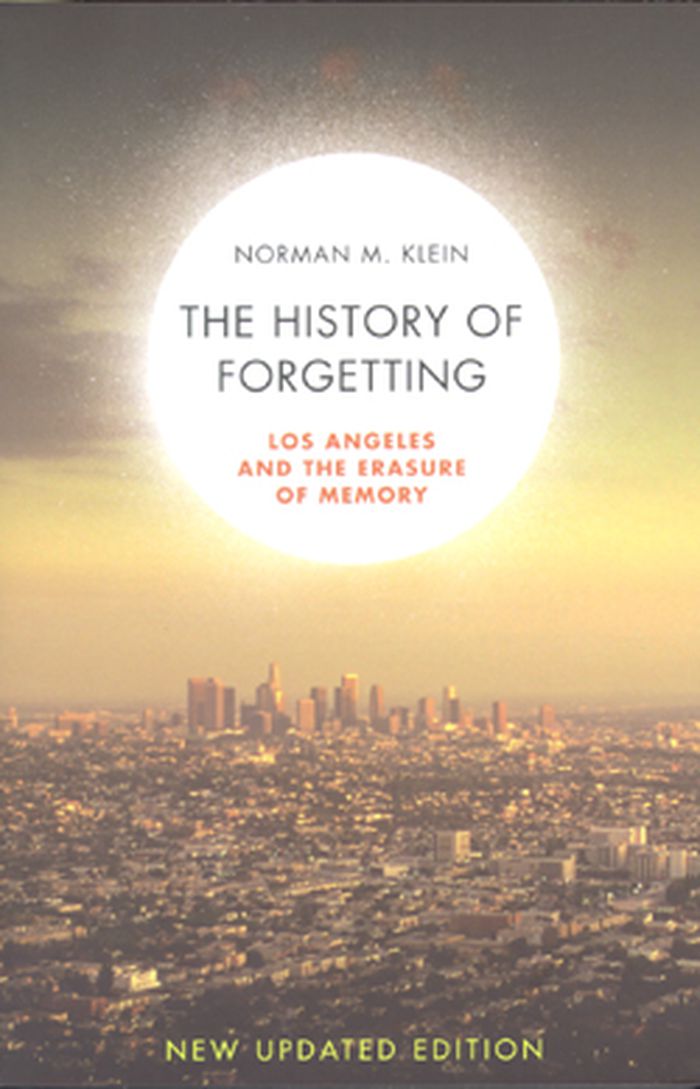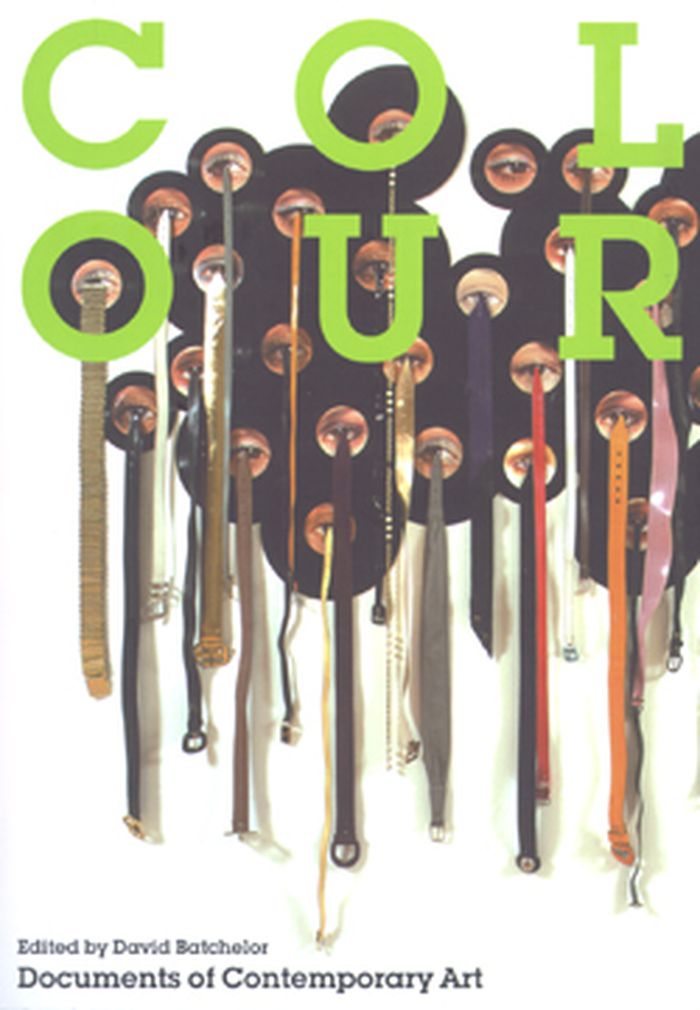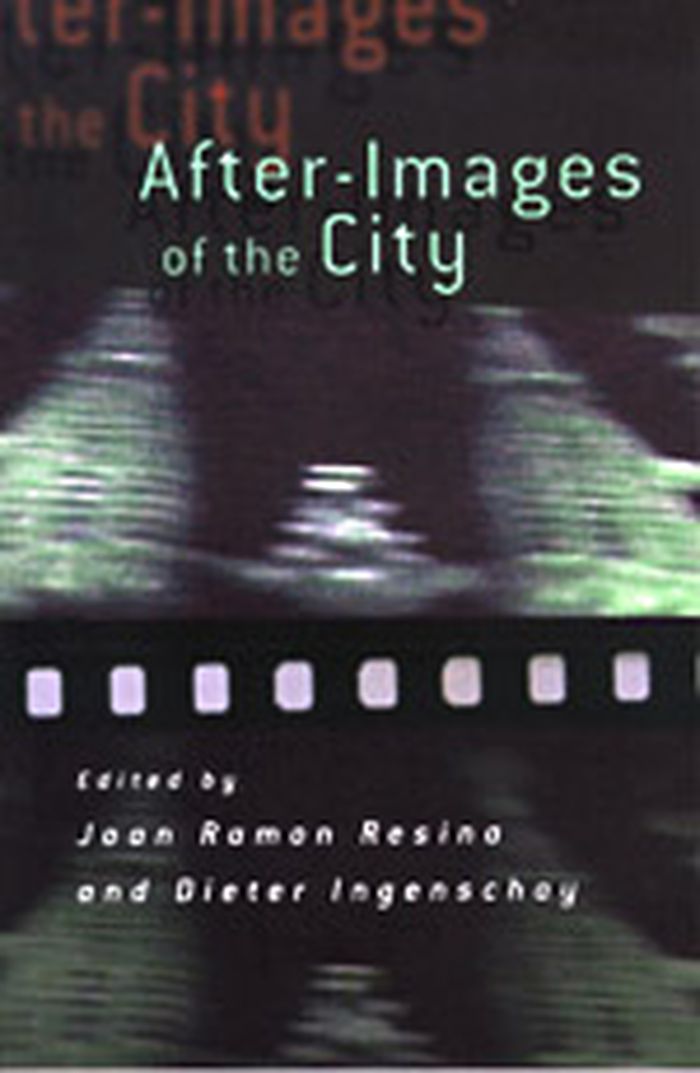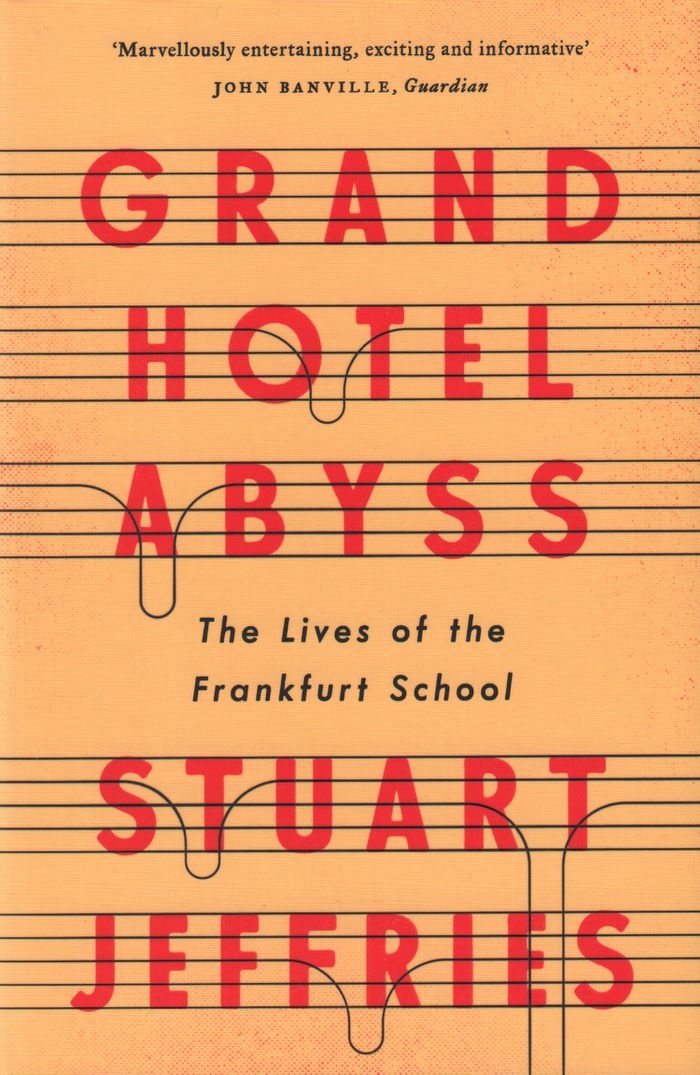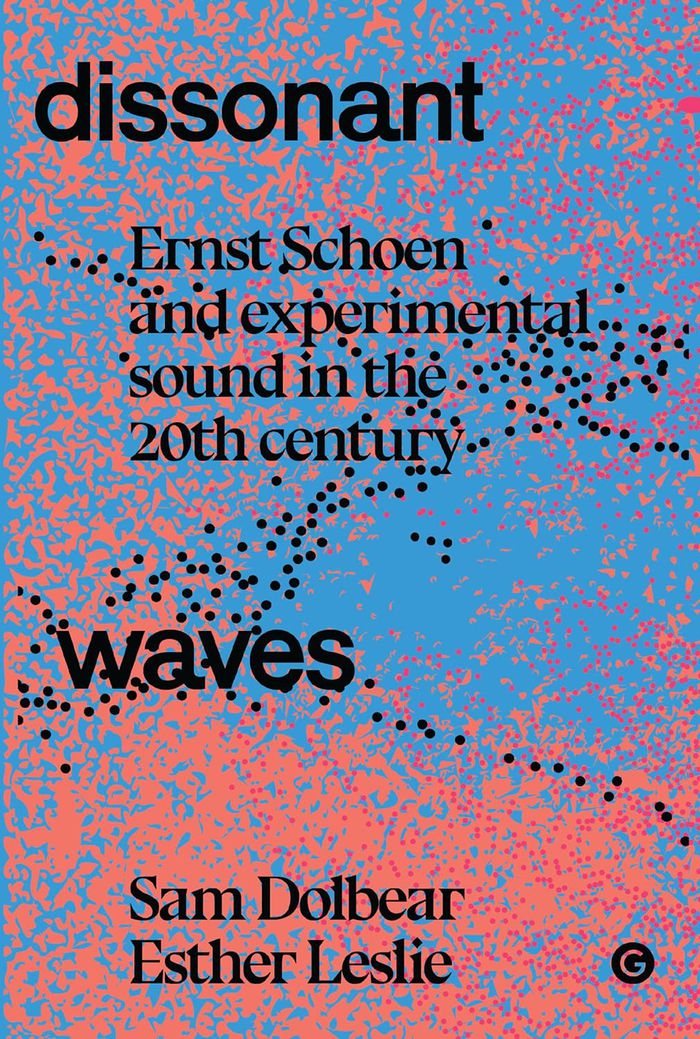$27.50
(available to order)
Summary:
Los Angeles is a city that has long thrived on the continual re-creation of its own myth. In this extraordinary work, Norman Klein examines the process of memory erasure in LA. Using a provocative mixture of fact and fiction, the book takes us on an "anti-tour" of downtown LA, examines life for Vietnamese immigrants in the City of Dreams, imagines Walter Benjamin as a Los(...)
The history of forgetting: Los Angeles and the erasure of the memory
Actions:
Price:
$27.50
(available to order)
Summary:
Los Angeles is a city that has long thrived on the continual re-creation of its own myth. In this extraordinary work, Norman Klein examines the process of memory erasure in LA. Using a provocative mixture of fact and fiction, the book takes us on an "anti-tour" of downtown LA, examines life for Vietnamese immigrants in the City of Dreams, imagines Walter Benjamin as a Los Angeleno, and finally looks at the way information technology has recreated the city, turning cyberspace into the last suburb. In this new edition, Norman Klein explores the evolution of the Latino majority, how the Pacific economy is changing the structure of urban life, the impact of collapsing infrastructure in the city, and the restructuring of those very districts that had been "forgotten." Norman M. Klein is a critic and historian of mass culture, author of most recently, The Vatican to Vegas: The History of Special Effects. He teaches at the California Institute of the Arts in Los Angeles.
Urban Theory
books
$35.00
(available to order)
Summary:
In this short, intentionally polemical book, Neil Leach draws on the ideas of philosophers and cultural theorists such as Walter Benjamin and Jean Baudrillard to develop a novel and highly incisive critique of the consequences of the growing (...)
The anaesthetics of architecture
Actions:
Price:
$35.00
(available to order)
Summary:
In this short, intentionally polemical book, Neil Leach draws on the ideas of philosophers and cultural theorists such as Walter Benjamin and Jean Baudrillard to develop a novel and highly incisive critique of the consequences of the growing preoccupation with images and image-making in contemporary architectural culture. The problem with this preoccupation, Leach argues, is that it can induce a sort of numbness, as the saturation of images floods the senses and obscures deeper concerns. This problem is particularly acute for a discipline such as architecture, which relies heavily on visual representation. As a result, architects can become anaesthetized from the social and political realities of everyday life. In the intoxicating world of the image, the aesthetics of architecture threaten to become the anaesthetics of architecture. In this culture of aesthetic consumption, this "culture of the cocktail," meaningful discourse gives way to strategies of seduction, and architectural design is reduced to the superficial play of empty, seductive forms.
books
May 1999, Cambridge, Mass.
Architectural Theory
$28.95
(available to order)
Summary:
Artists surveyed include: Joseph Albers, Mel Bochner, Daniel Buren, Carlos Cruz-Diez, Robert Delaunay, Sonia Delaunay, Jimmie Durham, Helen Frankenthaler, Paul Gauguin, Donald Judd, Wassily Kandinsky, Paul Klee, Yves Klein, Kazimir Malevich, Piero Manzoni, Henri Matisse, Henri Michaux, Beatriz Milhazes, Piet Mondrian, Barnett Newman, Kenneth Noland, Hélio Oiticica, Paul(...)
Colour: Documents on comtemporary art
Actions:
Price:
$28.95
(available to order)
Summary:
Artists surveyed include: Joseph Albers, Mel Bochner, Daniel Buren, Carlos Cruz-Diez, Robert Delaunay, Sonia Delaunay, Jimmie Durham, Helen Frankenthaler, Paul Gauguin, Donald Judd, Wassily Kandinsky, Paul Klee, Yves Klein, Kazimir Malevich, Piero Manzoni, Henri Matisse, Henri Michaux, Beatriz Milhazes, Piet Mondrian, Barnett Newman, Kenneth Noland, Hélio Oiticica, Paul Signac, Ad Reinhardt, Gerhard Richter, Aleksandr Rodchenko, Bridget Riley, Mark Rothko, Yinka Shonibare, Jessica Stockholder, Theo van Doesburg, Vincent van Gogh, Victor Vasarely, Rachel Whiteread. Writers include: Theodor Adorno, Roland Barthes, Charles Baudelaire, Jean Baudrillard, Walter Benjamin, Charles Blanc, Jacques Derrida, Thierry de Duve, Umberto Eco, Victoria Finlay, Joris-Karl Huysmans, Johannes Itten, Julia Kristeva, Claude Lévi-Strauss, Jacqueline Lichtenstein, Maurice Merleau-Ponty, John Ruskin, Adrian Stokes, Ludwig Wittgenstein. About the Editor: David Batchelor is an artist and writer who has exhibited widely in Europe and America. Senior Tutor in Critical Theory in the Department of Curating Contemporary Art at the Royal College of Art, London, he is a frequent contributor to such journals as Artforum and Frieze and the author of Minimalism and Chromophobia.
Art Theory
books
$35.50
(available to order)
Summary:
Critical theories such as those of the Frankfurt School of the twenties and thirties gave rise to a complex and sophisticated critique of modernity and modernism. The history and theory of twentieth-century architecture, which developed rather independently of (...)
Architecture and modernity : a critique
Actions:
Price:
$35.50
(available to order)
Summary:
Critical theories such as those of the Frankfurt School of the twenties and thirties gave rise to a complex and sophisticated critique of modernity and modernism. The history and theory of twentieth-century architecture, which developed rather independently of this rich tradition, appear naive and unbalanced in comparison. In this exploration of the relationship between modernity, dwelling, and architecture, Hilde Heynen attempts to bridge this gap between the discourse of the modern movement and cultural theories of modernity. On one hand, she discusses architecture from the perspective of critical theory, and on the other she modifies positions within critical theory by linking them with architecture. She assesses architecture as a cultural field that structures daily life and that embodies major contradictions inherent in modernity, arguing that architecture nonetheless has a certain capacity to adopt a critical stance vis-à-vis modernity. The book provides architectural students with an introduction to the discourse of critical theory. The subchapters on Walter Benjamin, Ernst Bloch, Theodor Adorno, and the Venice School (Tafuri, Dal Co, Cacciari) can be studied independently.
books
April 2000, Cambridge, Mass.
Architectural Theory
After-images of the city
$27.95
(available to order)
Summary:
Criticism on the textual and iconographic construction of the city is extensive, yet the problem of historical change in representations of "the urban" has received little attention. Believing traditional accounts are limited by their reflection of a specific historical moment, Joan Ramon Resina and Dieter Ingenschay focus, by contrast, on transition. In essays written(...)
Urban Theory
February 2003, Ithaca, N.Y.
After-images of the city
Actions:
Price:
$27.95
(available to order)
Summary:
Criticism on the textual and iconographic construction of the city is extensive, yet the problem of historical change in representations of "the urban" has received little attention. Believing traditional accounts are limited by their reflection of a specific historical moment, Joan Ramon Resina and Dieter Ingenschay focus, by contrast, on transition. In essays written for this volume, scholars of literary and visual studies, the history of architecture, cultural theory, and urban geography explore the ways perceptual or conceptual paradigms of the city supersede or replace others, while at the same time retaining the "after-image" of what went before. The writers touch on a wide variety of issues related to contemporary urban cultures as they journey through cities including New York, Barcelona, Madrid, Paris, Tijuana, Berlin, and London. Drawing on the work of Roland Barthes, Walter Benjamin, Camilo José Cela, Honoré de Balzac, and Alfred Stieglitz, their approach is broadly cultural rather than technical. "After-images of the city" takes into account the intrinsic instability of the image and reveals that representations of the modern metropolis cannot be fixed in time and history.
Urban Theory
$56.00
(available to order)
Summary:
"Shopping" signifies more than the pure purchasing of goods. Strolling, looking at, choosing, buying and consuming goods has long become an essential part of urban life in the 20th century. Shopping is an essential ritual of public life, creating and transforming identity. Ever since Walter Benjamin´s description of the flaneur in the Paris arcades, the complex(...)
Contemporary Art Monographs
December 2002, Ostfildern
Shopping : a century of art and consumer culture
Actions:
Price:
$56.00
(available to order)
Summary:
"Shopping" signifies more than the pure purchasing of goods. Strolling, looking at, choosing, buying and consuming goods has long become an essential part of urban life in the 20th century. Shopping is an essential ritual of public life, creating and transforming identity. Ever since Walter Benjamin´s description of the flaneur in the Paris arcades, the complex interchanges between consumer culture and art have become an issue worthy of discussion, and the book Shopping is the first extensive publication to be dedicated to this topic. It documents and analyses the fascination of fine artists, architects, film makers with the more and more sophisticated means of seduction in shop windows, department stores and shopping arcades. Extensive pictorial material serves to illustrate the interaction between art and the consumption of goods using works by Eugène Atget, Berenice Abbott, Walker Evans, Andy Warhol, Claes Oldenburg, Roy Lichtenstein, Christo, Duane Hanson, Barbara Kruger, Jeff Koons, Andreas Gursky, and many more. The book is edited by Christoph Grunenberg and Max Hollein and includes contributions by internationally renowned authors.
Contemporary Art Monographs
books
$60.00
(available to order)
Summary:
Critical theories such as those of the Frankfurt School of the twenties and thirties gave rise to a complex and sophisticated critique of modernity and modernism. The history and theory of twentieth-century architecture, which developed rather independently of (...)
Architecture and modernity : a critique
Actions:
Price:
$60.00
(available to order)
Summary:
Critical theories such as those of the Frankfurt School of the twenties and thirties gave rise to a complex and sophisticated critique of modernity and modernism. The history and theory of twentieth-century architecture, which developed rather independently of this rich tradition, appear naive and unbalanced in comparison. In this exploration of the relationship between modernity, dwelling, and architecture, Hilde Heynen attempts to bridge this gap between the discourse of the modern movement and cultural theories of modernity. On one hand, she discusses architecture from the perspective of critical theory, and on the other she modifies positions within critical theory by linking them with architecture. She assesses architecture as a cultural field that structures daily life and that embodies major contradictions inherent in modernity, arguing that architecture nonetheless has a certain capacity to adopt a critical stance vis-à-vis modernity. The book provides architectural students with an introduction to the discourse of critical theory. The subchapters on Walter Benjamin, Ernst Bloch, Theodor Adorno, and the Venice School (Tafuri, Dal Co, Cacciari) can be studied independently.
books
November 1998, Cambridge, Mass.
Architectural Theory
books
$48.00
(available to order)
Summary:
This book introduces to an English-language audience the writings of the so-called New Vienna School of art history. In the 1930s Hans Sedlmayr (1896-1984) and Otto Pächt (1902-1988) undertook an ambitious extension of the formalist art historical project of Alois (...)
The Vienna School reader : politics and art historical method in the 1930s
Actions:
Price:
$48.00
(available to order)
Summary:
This book introduces to an English-language audience the writings of the so-called New Vienna School of art history. In the 1930s Hans Sedlmayr (1896-1984) and Otto Pächt (1902-1988) undertook an ambitious extension of the formalist art historical project of Alois Riegl (1858-1905). Sedlmayr and Pächt began with an aestheticist conception of the autonomy and irreducibility of the artistic process. At the same time they believed they could read entire cultures and worldviews in the work of art. The key to this contextualist alchemy was the concept of "structure," a kind of deep formal property that the work of art shared with the world. Sedlmayr and Pächt's project immediately caught the attention of thinkers like Walter Benjamin who were similarly impatient with traditional empiricist scholarship. But the new project had its dark side. Sedlmayr used art history as a vehicle for a sweeping critique of modernity that soon escalated into nationalist and outright fascist polemic, even while Pächt, a Jew, was forced into exile. Sedlmayr and the whole scholarly project of Strukturanalyse were sharply repudiated by Meyer Schapiro and later Ernst Gombrich. After an introductory essay, the book opens with two selections from Riegl. The next section includes two essays by Sedlmayr, two by Pächt, and one each by Guido Kaschnitz-Weinberg and Fritz Novotny, all dating from the 1930s. The book closes with the divergent responses of Benjamin (1933) and Schapiro (1936). The difference of opinion between these two key voices raises again the question of the legitimacy and effectiveness of the method, and reveals the analogies between the New Vienna School project and the antiempiricist cultural histories of our own time. The book also contains an extensive bibliography.
books
January 1900, New York
Architectural Theory
$22.99
(available to order)
Summary:
In 1923, a group of young radical German thinkers and intellectuals came together to at Victoria Alle 7, Frankfurt, determined to explain the workings of the modern world. Among the most prominent members of what became the Frankfurt School were the philosophers Walter Benjamin, Theodor Adorno, Max Horkheimer, and Herbert Marcuse. Not only would they change the way we(...)
Grand Hotel Abyss: the lives of the Frankfurt school
Actions:
Price:
$22.99
(available to order)
Summary:
In 1923, a group of young radical German thinkers and intellectuals came together to at Victoria Alle 7, Frankfurt, determined to explain the workings of the modern world. Among the most prominent members of what became the Frankfurt School were the philosophers Walter Benjamin, Theodor Adorno, Max Horkheimer, and Herbert Marcuse. Not only would they change the way we think, but also the subjects we deem worthy of intellectual investigation. Their lives, like their ideas, profoundly, sometimes tragically, reflected and shaped the shattering events of the twentieth century. "Grand Hotel Abyss" combines biography, philosophy, and storytelling to reveal how the Frankfurt thinkers gathered in hopes of understanding the politics of culture during the rise of fascism. Some of them, forced to escape the horrors of Nazi Germany, later found exile in the United States. Benjamin, with his last great work—the incomplete Arcades Project—in his suitcase, was arrested in Spain and committed suicide when threatened with deportation to Nazi-occupied France. On the other side of the Atlantic, Adorno failed in his bid to become a Hollywood screenwriter, denounced jazz, and even met Charlie Chaplin in Malibu. After the war, there was a resurgence of interest in the School. From the relative comfort of sun-drenched California, Herbert Marcuse wrote the classic One Dimensional Man, which influenced the 1960s counterculture and thinkers such as Angela Davis; while in a tragic coda, Adorno died from a heart attack following confrontations with student radicals in Berlin. By taking popular culture seriously as an object of study—whether it was film, music, ideas, or consumerism—the Frankfurt School elaborated upon the nature and crisis of our mass-produced, mechanised society. Grand Hotel Abyss shows how much these ideas still tell us about our age of social media and runaway consumption.
Critical Theory
$45.95
(available to order)
Summary:
Dials, knobs, microphones, clocks; heads, hands, breath, voices. Ernst Schoen joined Frankfurt Radio in the 1920s as programmer and accelerated the potentials of this collision of bodies and technologies. As with others of his generation, Schoen experienced crisis after crisis, from the violence of war, the suicide of friends, economic collapse, and a brief episode of(...)
Dissonant waves: Ernst Schoen and experimental sound in the 20th century
Actions:
Price:
$45.95
(available to order)
Summary:
Dials, knobs, microphones, clocks; heads, hands, breath, voices. Ernst Schoen joined Frankfurt Radio in the 1920s as programmer and accelerated the potentials of this collision of bodies and technologies. As with others of his generation, Schoen experienced crisis after crisis, from the violence of war, the suicide of friends, economic collapse, and a brief episode of permitted experimentalism under the Weimar Republic for those who would foster aesthetic, technical, and political revolution. The counterreaction was Nazism—and Schoen and his milieux fell victim to it, found ways out of it, or hit against it with all their might. ''Dissonant waves'' tracks the life of Ernst Schoen—poet, composer, radio programmer, theorist, and best friend of Walter Benjamin from childhood—as he moves between Frankfurt, Berlin, Paris, and London. It casts radio history and practice into concrete spaces, into networks of friends and institutions, into political exigencies and domestic plights, and into broader aesthetic discussions of the politicization of art and the aestheticization of politics. Through friendship and comradeship, a position in state-backed radio, imprisonment, exile, networking in a new country, re-emigration, ill-treatment, neglect, Schoen suffers the century and articulates its broken promises.
Acoustics
